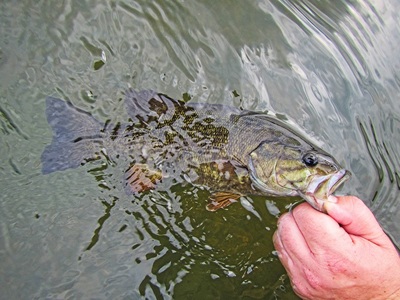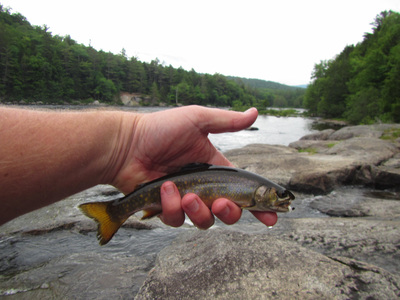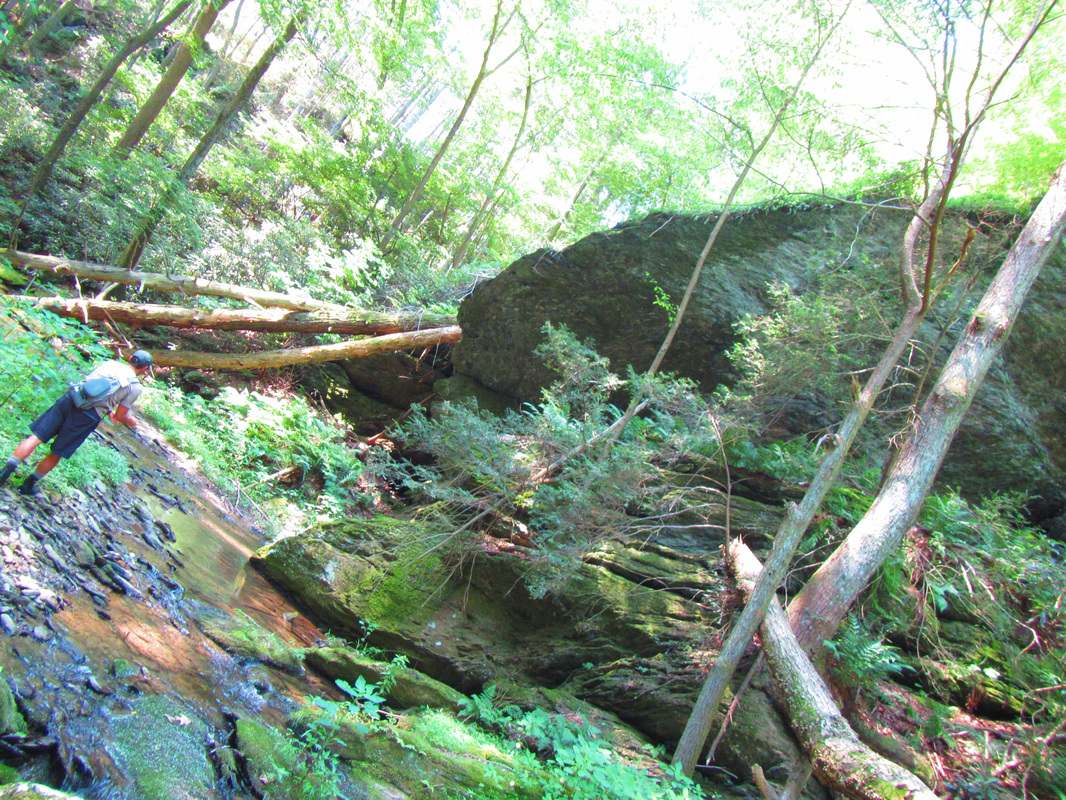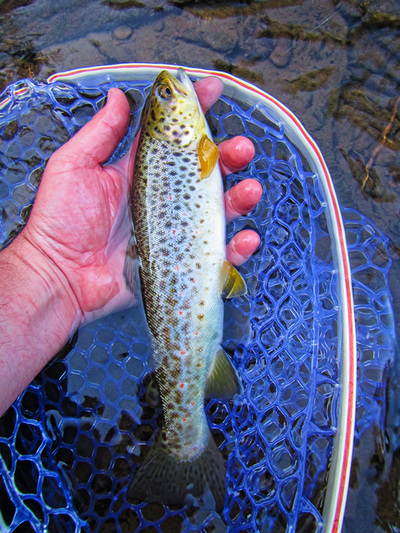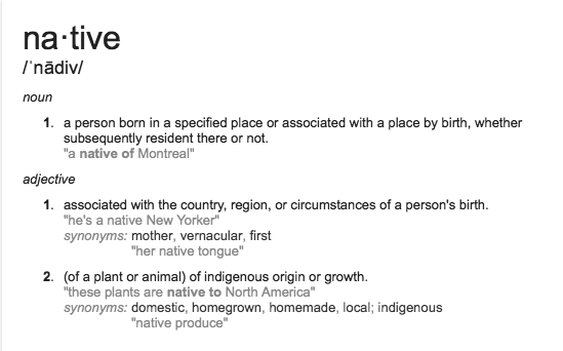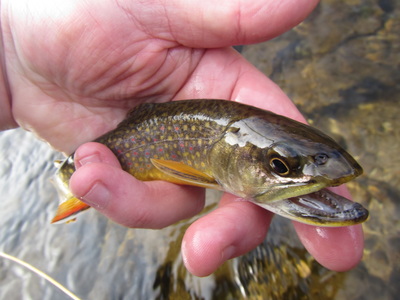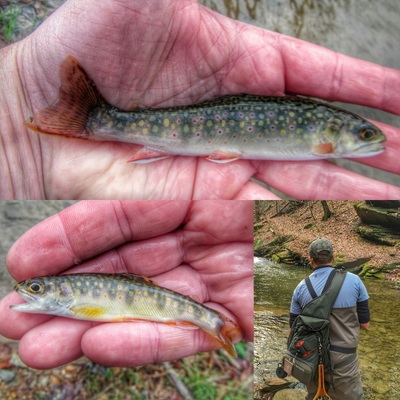 "A clean patch of ground after a rain an ancient pine half-covered with moss such things appear before our eyes but what we do with them isn't the same" -Stonehouse There's a county up near where I live that is the pariah of the Susquehanna watershed. Whenever anyone has an incest or meth joke to tell, they be sure to locate it there. It gets written off fairly quickly and regularly, even by neighboring politicians who make bureaucratic jokes at its expense. Most people see it from the interstate - a nice farm valley butting up against a slice of the Appalachians. In the winter, like today, the mountaintops have a glittering of frost on them, like grouse tracks traversing the ridge line. Most of the crevices and caverns aren't seen by anyone but the locals; I think they like to keep it that way.
I took a drive up there today to explore two different watersheds. The day didn't warm until right before lunch, when the sun was halfway through. I started on some nice water in search of roaming brown trout. A few deep pockets and nice runs to check out for the spring, when water is up a bit more. I followed it up to it headwaters and found brook trout before cutting up and across the mountain down into a hemlock holler that cradled shavings of some riffles and runs. It was getting on into the afternoon by the time I crested the last ridge and headed down into Henry's Valley. The last creek turned out to be the most enjoyable. The stone were freer when they tumbled down this ravine and in return, they were rewarded with a plethora of cold springs. Ice shelves created pocket water and opaque slices up and downstream. I found a frozen over beaver pond that will be great to fish in the late spring.
0 Comments
 "Along the Girard Ridge" We hitched for nine days up along the Girard Ridge. Shasta to our north, giving us looks all day. Frost over the sixth night. Along the Girard Ridge we spread like sinuses on a cold morning. The crew went through with loppers first then brush-cutters and pole saws to widen the trail. Some dusty tread work with McCloud and Pulaski to finish the hitch. Pine pitch to start fires, a bag of potato chips as a snack.  It's been a slow fall of fishing for me. Points just didn't seem to connect throughout the last two months. I ended the summer of fantastic bass fishing and big Maine brook trout and landlocked salmon by falling quickly back into a deluge of work. I lost all my headspace that allowed me to explore in a pile of papers and lesson plans. So it goes. No complaining here. Sometimes it's just hard to not let your life become, as Jim Harrison mused, "the sloppy leftovers of your work." This is just to say that it's easy for me to trace my life over the lines of fishing and come up with a pretty dynamic and accurate portrait of how I've been living. The past few months have held very few points and the lines that were connected seemed short and didn't draw much more than a few incoherent shapes that look like they were traced left handed by a right handed person. Pretty symbolic of how I've been feeling. 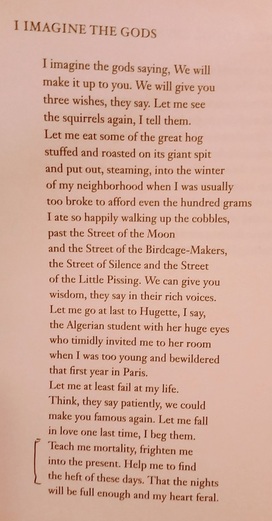 It's easy for us to measure our life by one or two points: relationships, work, hobbies, money, politics, things, whatever our focus goes to, and not take into account the whole landscape of what we've been living. Now that the leaves are mostly down and the sun is gone by 6, I'm left with some space for reflection. It's easier to see further when the trees are naked, but you have less time for it. Anyway, a few points have bolded themselves and have marked the last few months. One has been Jack Gilbert. Life seems to always go back to his words. There is one poem that I keep coming back to, rereading every other day - "I Imagine the Gods" . Two lines in particular. "Teach me mortality, frighten me into the present, Help me to find the heft of these days." If ever there was a prayer that I should say every day, this is it. On a purely stylistic note, I absolutely love his choice of "heft" instead of "weight". Completely different connotations in this context. Weight holds us down, requires strength to maneuver. Whereas Heft has the duality of functioning as both a noun and verb, thereby not immediately attaching itself to its root meaning of weight, but also of action and active engagement in the moment. There's been a lot of discussion about whether or not Dylan should have won the Nobel Prize in Literature. I'm firmly in the camp that he is well deserving of the accolade. Here's why.
All of what we consider to be Literature came from the Oral Tradition. Stories like Beowulf, The Odyssey, The Illiad, are the foundations of our language and story. These stories were created with breath and given to the air through a scop or someone like Homer usually accompanied by a Harp or instrument. Dylan is simply an extension of that, therefore, I consider his work Literature. You can read his lyrics off the page or listen to it with music, both have their individual effect and emphasis on the word. Add a different voice to it, the effect changes. Change the instrumentation, and the meaning/mood will change. One could argue that Dylan's writings are more dynamic than a novel in that regard. Take Shakespeare and his works as an example. Reading a Shakespeare play is dramatically different from witnessing it. The lines take on different meaning based on individual performances by actors & actresses. Make changes in tone, setting, backdrop, costume, and performers and the play takes on a different meaning and effect for the audience. Change the audience and you'll change the play. Dylan's lyrics can be read from the page for one effect, then performed in many different ways by different people using different instruments; each singular way projects a different interpretation and meaning. Take, for example, "All Along Watchtower". It can be read one way on the page without any singing or instruments (I read the tone very different than the album version - pleading, desperate); however, listening to his version off of "John Wesley Harding" can impart a different mood and voice (laconic, matter-of-fact). Then, take Hendrix's electrified version and the song takes on a completely different meaning (apocalyptically urgent, intensely fried) . It's great Literature either way and up for endless interpretation. There is also the argument that a lot of modern Literature, and even some of the writers that were/are also in consideration for the Nobel (Murakami is the most obvious), wouldn't be possible without Dylan's lyrics. His influence both on artists and language is undeniable and, at least in my opinion, larger than any other modern writer. Dylan's lyrics contain everything great Literature has: story, characters, conflict, theme, and a universal appeal. They can be read off the page, sung to yourself while you walk up a stream, witnessed in concert with thousands of others, performed by anyone, and translated into other languages. Without Dylan's work, the culture of the world and the literary landscape would be without a foundational block that thousands have used in order to create their own art.  The sultry September summer air drifted in through the open doors of the theater mixing the smell of decaying plaster and patchouli; reminiscent of the mixed generations of people who showed up for a beautifully intimate performance by Steve Gunn in the lobby of the historic Lansdowne Theater. Industrial fans, set up like sentries at both sides of the lobby where the bathrooms once were, blew through the heavy humidity. Light, occasionally flickering in, found its way onto the ancient scrolls of flaking paint on the walls and ornate carvings marking steps across the ceiling. Faded paintings of ships sailed above the cracked concrete where fountains used to stand and greet visitors. With, at most, 100 seats, the lobby was completely full of people as an old friend of Mr. Gunn's took the stage to introduce him. His preamble was an amazing, rambling homage to the community that he and Steve created in Lansdowne as kids. It marked the occasion perfectly; this was a homecoming and a celebration of community, of saving a special part of the past for the future while performing in the present. As an outsider who never stepped foot in Lansdowne and, honestly, only came because I am in love with Gunn's music, I was moved by the connections to place, home, and family that were celebrated at last night's show that was set up to raise money to restore the Lansdowne Theater. The meandering introduction to "Water Wheel", relaxed and cyclical, like a a small stream low after a long drought gently pushing the wheel for another spin, set the rhythm for the night. Each song was full of Gunn's sweat and sweet improvisation. "Night Wanderer", about a cat prowling around Lansdowne at night, was next and the first track played off of his latest record, Eyes on the Lines. The song, stripped down like it was, connected eloquently back to the introduction and the powerful connection to this austere place the audience and musician have. 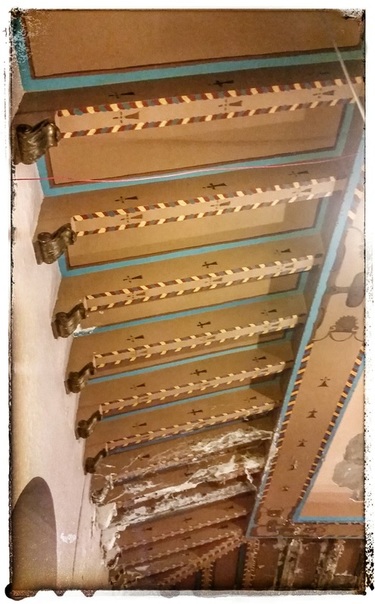 I was giddy when Gunn took a few minutes to tune his guitar and mention that, because of the heat, he was going to take the next song slow and that "it'll be kind of long". I knew it was going to be "Old Strange", a personal favorite of mine. Gunn played the intro for a few minutes and abruptly stopped to let us know that it was borrowed from an old Greek folk tune and that the song was in honor of a local Greek Pizzeria, which drew a loud applause from the hometown crowd. There's this lick inside of that track that, even when the music goes far beyond where it started, is still lifting the tune on its back and taking it through the dark woods and a "path through the fields/to find out what was real....". That riff shows up throughout my days, playing a subtle rhythm while I'm teaching the kids about the rhetorical situation or mowing my grass or walking Whitman down to the river. It's beautiful and I never want it to end. I could have sat there on that hard plastic folding chair with my eyes closed and listened to him play that song for hours, days, forever, just to watch that melody come back and leave, come back, leave, diminish, then expand, endlessly going back and forth and reaching itself out like a patch of mint that grows and dies and with each death comes back even taller and further out from where it sprouted.  Gunn then went into a set of newer numbers from the last two records - "Ancient Jules", "Milly's Garden", "Way Out Weather" and "Ark" with winsome stories about his championship youth soccer team (which, I think, Kurt Vile also played on), skateboarding in the parking lot out back, and his short run with the Boy Scouts scattered throughout. "Milly's Garden" was more of an improvisational track. He sang the first stanza a few times until eventually making his way to the chorus. We were left to fill in the rest of the lyrics as he kept coming back to remind us that "...your faith is savage, your mind is damaged, you're more than halfway there..." while taking the song into all the corners and cracks of the lobby. "Ancient Jules" has been the soundtrack to my summer since it came out earlier this year with the lines "take your time, ease up, look around, and waste the day". It was my mantra for my summer vacation and it took me to some beautiful places. Thank you, Steve. 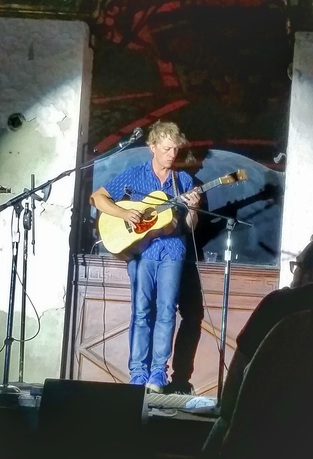 The show ended with "Wildwood", which Gunn mentioned was his father's, who recently passed, favorite song. He dedicated it to his mother and sister who were in the audience and mentioned how much it meant for him to play it that night; a perfect ending to this great homecoming and celebration of place, family, friends, and great music. Setlist: Water Wheel Night Wanderer Old Strange Ancient Jules Milly's Garden Way Out Weather Ark Wildwood  You can tell a lot about a person by their favorite Dylan record. If they don't have one, well, I'm not sure you even want to fish with them. I met Justin when I was taking my dog Whitman for a walk and Justin was walking back to his car after an evening of fly fishing on the river. I saw him with a fly rod so I struck up a conversation about the river and the fishing. We quickly discovered that we had a lot of common ground - he teaches writing at the college level, I teach high school English, he likes good music, I do to, and most importantly, we both like to fly fish. We quickly exchanged numbers and set a time to head out to the river in the near future.  He just moved into the area, so I took him to a spot on the Susquehanna that I recently discovered. This is my first season fly fishing for bass and I'm now in full bronze mode. These past few weeks have been terribly hot and humid - horrible weather for trout fishing. In past summers, I would have sulked and been agitated not being able to head out on the water. Realizing that I can have an incredible angling experience right outside of my house has been a gigantic blessing. Instead of driving all over the place looking for spring creeks and limestoners, I've been getting on my bike, riding up the rail-trail along the river, and drifting a crayfish pattern for beautiful bass. Talk turned to music once we were on the water and Dylan came up. I asked him what his favorite Dylan record was. "Time Out of Mind", he said. "Seriously? Mine too!". Yeah, I know, it's just a record, and really, who cares? But if you don't know that record or why it's one of Dylan's best, then that part of this anecdote will never make sense. Some day I'll do an entire post about the genius of that record. Either way, it's great to meet someone that understands the magnificence of that record. That record is everything that Dylan was meant to do as an artist. It quickly became obvious that we shared a lot of the same interests and that our lives had struck the same chords at some point or another. We hit it off and quickly started catching some really nice bass. I've lived most of my life within a few miles of this river and only now, in my 33rd rotation around the sun, have I spent a lot of time on it. Enough time to learn its rhythms and seasons. Rightfully so, the Susquehanna gets a lot of bad press. Ask any angler and they'll immediately start talking about how great the bass population USED to be. Ask any concerned citizen and they'll correctly tell you that the river should be listed as impaired and needs a lot of love in order to get it to a healthy, livable, sustainable standard. I agree with all of it. I love this river and it needs our help. However, we often easily get consumed by the negatives and the "what needs to happen..." mentality which can filter our view of the river and keep us from realizing the beauty that is right in front of us. If we don't see the beauty that we have, we'll never be willing to protect the beauty that may be. 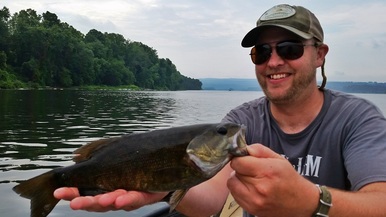 Over the past month and half, I've caught a ton of beautiful, healthy looking bass. Only one had a sore on it. I've also caught bass ranging from 8"-16". Justin recently landed a 20" and an 18". It's great to see the bass population seemingly doing well. They've been nailing dark poppers, crayfish patterns, and Clouser minnows; the deadly three when it comes to bass flies for me. If they are healthy and doing well, it also shows that the river has a lot of great things going on. If we don't acknowledge the vibrant ecosystem of the Susquehanna, we'll never care enough to keep it healthy and work to make it better. We aren't only catching really nice bass, but we're seeing a ton of egrets, herons, and bald eagles. Just the other day we stopped fishing to watch two bald eagles circle over use for a few minutes. Their nest must have been close. It has been a blast discovering this river. For my entire life it's always been in the periphery, but now it's coming into focus and I'm loving what I see. Get out there and enjoy the water. If we don't acknowledge the vibrant ecosystem of the Susquehanna, we'll never care enough to keep it healthy and work to make it better. 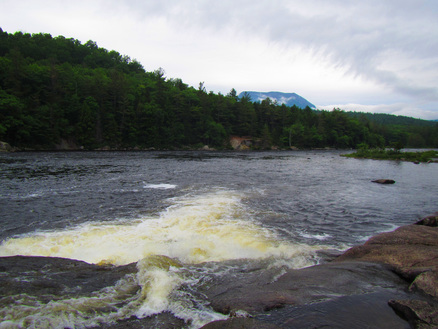 Nesowadnehunk falls, with Katahdin on the horizon Nesowadnehunk falls, with Katahdin on the horizon I hadn't stepped foot in Maine for almost ten years. A lot has changed since then. I no longer bust my back doing trail work, I'm married, I've got a great dog, I fly fish. I've been antsy to get back to the North Woods for awhile now, to check out some places that I used to go, to explore some new ones, and to catch some nice brookies and landlocked salmon. I love the wildness that still exists in Maine. After living out west and visiting most of the lower 48, I feel that Maine is the wildest state down here, Alaska light some might say. I could easily see myself making it my home one day. There's a lot of poetry to be written up along those cedar-lined banks.  Class 5 Rapids Class 5 Rapids After spending a few days on the coast, we took a rainy day and headed up to the West Branch of the Penobscot. The only way to get there is the Golden Road, a rough logging road that, if you get through without a flat tire or getting run down by a logging truck, you should count yourself lucky. It was pouring down rain when we got to camp, so we heated up some hot dogs on our stove and quickly crawled into bed to nap off the weather. It worked. By the time we woke up, the rain had broke. I took that first evening to explore the water right outside of camp.  I began fishing at the top of an eddy where a set of rapids came in, working the edges and the seams. The Penobscot is big water. Rafters use it all the time to send its Class 5 Rapids. I don't have much experience fishing water like this, so I took it small and fished the water right in front of me, trying to pick apart each current and little riffle. I eventually got into some nice wild brookies using a nymphing rig. While doing so, an old timer, Richard, came out to the river about 30 feet below me. He was throwing a big spoon in the rapid, but wasn't having any luck. With each fish I would land, we would just nod his head and give me a grunt. I took it as a good sign, like I was doing something right, something that he approved of. Eventually, I worked myself up to the top of the rapids and began nymphing a small eddy in the middle of two sets of pretty rough water. I landed my first landlocked salmon out of it, a small guy that took for me a wild ride. Landlocks are ferocious fish. They attack your fly and when hooked, will take you for runs up, down, and deep into the water. They'll jump a few feet out of the water, trying to shake that damn hook out. They're a blast. A large (at least for me) landlocked grabbed my hare's ear and took off down stream. I fought him for what seemed to be minutes (it wasn't), and eventually got him close to net. As I reached out to net him, I hear Richard yell, "Watch out for the eagle!" right as I come face to face with a large Bald Eagle swooping down, wings fully outstretched, talons out, trying to poach the salmon I'm about to land. Luckily, he misses by a few inches and flies away, down across the big eddy and perches himself at the top of a big pine, watching us for the rest of the night. It was enough to break the ice between Richard and I. We shared a good few minutes of amazed laughter and "Holy shits" before swapping stories about fishing and life in Maine. It was a great way to end my first night up in the North Woods. After a few days on the West Branch, we took another rainy morning and headed southwest to Lily Bay State Park, situated on Moosehead Lake. We took the Golden Road all the way to Kokadjo. 38 miles in 2 hours. It got rougher the further out we got, so we went a steady 15 mph. It was a great drive, though a bit stressful at times due to the road conditions. We did see a moose along the way. The road turns to pavement in Kokadjo so we decided to stop in at the general store to get a cup of coffee. As I pulled up, I could smell bacon wafting out of the windows. We got inside and immediately decided to get a second breakfast. It was one of the best breakfasts we've ever head. 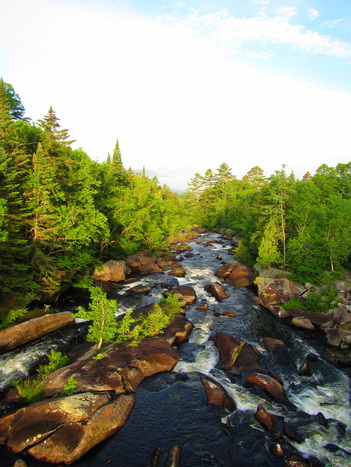 The Lower Magalloway is a beautiful tailwater just outside Rangeley, Maine. I only had a morning to fish, so I woke up wicked early and took a long hike to get into some good water. It was worth it. I was taking the skunk until I tied on a bugger with a nymph dropper and started stripping it up the banks of the river. I quickly got into some nice brookies and salmon. I worked my way downstream until I got to a really nice looking pool. I picked up a few more fish stripping the bugger and then, due to the time of the day, decided to throw on a nymph rig and see what I could pick up. I quickly got into some of the nicest, largest wild brook trout I've ever landed. They were all in the 12-14 inch range. The largest and last fish I pulled out of the pool was between 15 and 16 inches. Unfortunately he slipped out of the net before I could take a photo of him, But the old timer in hip boots on the other side of the pool gave me a thumbs up, so just ask him about it. I threw on a big stimulator and worked my way back to the car, picking up a handful of brookies and landlocks along the way. It was a great morning of fishing and I can't wait to go back.  We finished our trip with a few days in the White Mountains. After doing some hiking and checking out some falls, I fished some nice water in the National Forest. Using a 3 wt and a big stimulator, I was able to bring a few native brookies and some wild rainbows to hand. After fishing some really big water in Maine, fishing these wild mountain freestone streams was a nice way to clear the head and keep things simple. A good way to end the trip. I really dig a spot that makes you feel like you're in a completely different place than where you woke up at. I took my good friend to a stream just out our backdoor that holds wild browns. This place requires some work to get to, which means very few people venture to it. As you drop into the ravine, the air immediately grows cooler and the susurrus of water drowns out all other noise. You are transported to a wildness that is extremely hard to find in the haze and congestion of this area. I know the angle of that photo is odd, but I wanted to capture the giant slab of a rock that is jutting out the side of the hill. If one was so inclined, a boulder pad and climbing shoes would open up an entire world of possibility throughout this area. My buddy brought quite a few nice fish to hand with a beetle smacked on the water. The fish are spooky and with the low water they were mostly found in fast riffles hugging boulders and rock shelves. #8
Clambering up the Cold Mountain path, The Cold Mountain trail goes on and on: The long gorge choked with scree and boulders, The wide creek, the mist-blurred grass. The moss is slippery, though there's been no rain The pine sings, but there's no wind. Who can leap the world's ties And sit with me among the white clouds? - Han Shan, Cold Mountain Poems  I was last here two years ago. We came up to the Catskills mainly to christen our new-to-us pop-up camper and to take our dog, Whitman, on his first camping trip. Fishing was definitely at the top of my list of reasons to check this area out, but it wasn't the only one, therefore, I only got to check out a few of the hundreds of miles of great fishing up that way. This time around, we were just taking a couple of days to get out of the lazy summer routine we find ourselves falling into once school is out. We were also showing the ropes to a friend who recently decided to get back into camping. This is just to say that there is still a ton of stream I want to explore. The water temperatures got too hot to fish come 8 a.m. each morning, so I only had a couple of hours of fishing each day. Luckily, our campsite was right along the river, which let me wake up, make a quick cup of coffee, let it cool while I put on my boots and rigged up, slam it down, and head out on the stream. The last time I was here, I wasn't tying any flies and was just getting into fly fishing. I went home with a few fish landed and a good memory, happy that I caught trout in the Catskills. This time around, I wanted to fish some of the holes I remembered from last time and see how I could do. Have I progressed at all? What have I learned? How is my approach different? What did I miss last time? This is where the idea of revisiting water became so important to me. Like a notch on your walking stick that you carve after climbing a peak or venturing into a place that you've always wanted to, catching trout on a stream that you've already fished can act as a mark in time to show your progress as an angler. It's not always about the numbers or the size, seriously. I know that's said a lot, but it really isn't, only when it is. Having already fished this water, I wanted to see if I could catch more trout and hopefully some bigger ones on flies I tied. If I did that, then it would show me that I have grown in my craft of angling and in the art of stream approach.  So, did I? Yeah, I did, and it felt really damn good. I only got to fish a few hours each of the two mornings I was there, but that was enough time to land some really nice looking fish on flies I tied. The dry-dropper rig worked best, with a fat orange stimulator as my dry and a hare's ear or hot spot pheasant tail as my nymph. The brookies tended to really dig the stimulator while the browns scarfed up the nymph. I was especially stoked when I landed this dude on a hare's ear nymph that I've been tying a lot lately (and catching a ton of fish on). He was sitting in a short, deep pool behind a large boulder sipping bugs as they flew by in the express lane seams created by a series of rocks laid out in the stream like three thumbs up. This brown trout is definitely one of the largest I've landed on a fly I've tied. Based on my net, he's between 17 and 18 inches. He took me up stream hard when I set the hook and I slowly worked him back down towards me and over to shallow water where I could net and quickly release him. This is one of those trout that will be a mark of a moment for me. One that I will go back to and replay in my head when it's cold and rainy outside. I'll venture back to that spot and work through my approach, how I added just a bit of weight to my line right before casting, where I let the fly drop so it would follow the inside of the seam and drop quickly into the pool right behind the boulder, how his take was subtle, but fierce at the same time, and how we played each other until we were released from that moment.  It wasn't just a fly fishing trip, which is a nice change of pace for me. The last few camping trips I've gone on have been focused on the water (something that will never get old for me). This trip took us on a beautiful hike to a mountain pond and meandering around back roads, exploring the mountains. The Catskills are beautiful. Life is good when you can just get in the car and explore with good people.  First fish of the trip. First fish of the trip. I spur my horse through the wrecked town, The wrecked town sinks my spirit. High, low, old parapet-walls Big, small, the aging tombs. I waggle my shadow, all alone; Not even the crack of a shrinking coffin is heard. I pity all these ordinary bones, In the books of the Immortals they are nameless. - Han Shan #4, Cold Mountain Poems.  Head for the mountains; my first inclination and instinct when my summer vacation starts. I packed some books, fly rods, good food and brew, and headed up to Potter County to get away from the constant murmur of traffic and work that seems to have taken a strong, subtle hold of life here in Lancaster County. The winds shot up Route 44, tracing along dark early spring clouds and short bursts of showers as I weaved my way down into the valley. Within a half hour of pulling into my campsite, I was set up and back in the car to pick up some flies from the Kettle Creek Tackle Shop, one of my favorite fly shops. The owner is always eager to share some stories and knowledge and he has over 300 of his own, hand made fly rods for sale. One of these days I'm going to pick up one of his bamboo rods. One of these days. I was on the water soon thereafter and quickly hooked into a mess of rainbows and native brook trout.  I got up early the next day and hiked up into a beautiful wild area. I only scratched the surface of one of the more remote places in Pennsylvania, and am looking forward to taking a full day to fully explore the stream. The afternoon brought more rainbows. So many that I started trying new flies and different techniques, just to see what would happen. I was hoping for more wild fish, but I'll still take a 30-40 fish day over getting skunked every time. Every time a few bugs started coming off the water, a burst of wind would tumble down the mountains and put them back down. A hare's ear variation that I tied up before the trip landed most of my fish. In fact, most of the fish I landed the entire trip were on flies I tied. A big improvement over the last time I was up here a year ago where I didn't even know how to dub a hook.  That evening, after a killer supper of rotisserie chicken soft tacos, I ventured upstream and soon found myself in a thick haze of bugs - mayflies, some sulphurs, and even some slate drakes. This part of the stream held a lot more wild fish and browns. They were keyed in on Light Cahills and the evening quickly became one I'll remember for a long time, a memory that I'll go back to and re-fish when I'm lost in a daze of work and habit. One after the other, these trout would swoop up from their deep lies and hit my fly. Eventually, I realized that I didn't need to count fish anymore and instead fell into the upstream moment, looking for the next seam to throw my dry. I fished until dark and took a nice long stroll back to camp under a beautiful summer night sky.  I settled at Cold Mountain long ago, Already it seems like years and years. Freely drifting, I prowl the woods and streams And linger watching things themselves. Men don't get this far into the mountains, White clouds gather and billow. Thin grass does for a mattress, The blue sky makes a good quilt. Happy with a stone underhead Let heaven and earth go about their changes. - Han Shan #7, Cold Mountain Poems  My buddy Scot came up to meet me early the next morning. We had a quick chat about the state of the world over some coffee and oatmeal, then headed out to a nice size trib teaming with wild browns and native brookies. Within the first run I fished, I hooked a double on a GW emerger and hare's ear. My first time ever catching two fish on both flies I was fishing. This was definitely one of my favorite streams I fished the entire trip. It's a classic mountain freestone with deep pools, fertile riffles, and plenty of room to make a back cast. When I head back up there later in the summer, I'm already planning on spending more time fishing it. To get over to Scot's camp, we weaved our way through the mountains bordering a Wild Area and down into the next valley over. I love these long dirt roads that traverse the mountains. It reminds me of being out west and driving through National Forest lands. You could spend a day just getting lost on them, stopping where it seems right, fishing for native brook trout. There's a freedom you only get where there are no stop signs or pavement and if you break down, your walking miles to get to a camp with a phone. 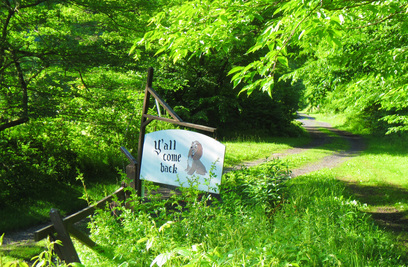 That last few days of my trip were spent at Scot's camp with Kurt and Andy, helping them christen their new-to-them old-school-trailer that they rented (appropriately named Wild Boy Hops & Trout Camp). I am blessed to have good people in my life willing to share their places, their knowledge, their jokes (Kurt is the best joke teller I have ever met, a master of the lost oral tradition of making people laugh with great timing and a good pun), and cured meats (not a euphemism). We explored the valley, caught a ton of fish, sat by the fire while an old white skunk skulked around us, and ate great charcuterie. It was an awesome trip and just what I was looking for to start my summer. I explored a bunch of new water, landed over 100 fish (most on flies I tied), embraced some magnificent solitude, hung out with good friends, and had beautifully deep sleep each night. I can't wait to head back up there. 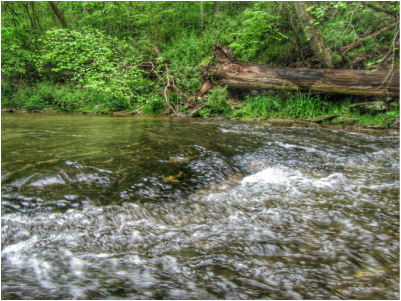 Waking up in a fog of early morning rain amid the leftover smoke from last night's fire, I wonder, Where will I fish today?  When I first arrived at the stream this morning there were already two cars parked. Being a wild trout stream that gets stocked, I usually don't see anyone on it after the first few weeks of opening day, so I was a bit surprised and had an "Ah, man" moment. Do I stay and fish behind these guys or go somewhere else and do some exploring? It had rained all morning and the clouds coming up over the next hill seemed to want to tell the same story as their fellas that ran through in the morning, so I decided to stay and see what I could conjure up. I walked a bit upstream through tall grass weighed down with fresh rain until I came up on a nice, deep hole. With my third cast, I brought to hand a wild brown. Then, another, and another. It went like that for a good hour as I worked my way upstream. Every hole, riffle, and eddy I fished gave up at least one fish. I eventually ran into to the guys that had gotten here in the rain and realized why I was doing so well; they were both fishing with spin rods while I had been nymphing low and deep. We were fishing the water differently. And that's how the day went. I stopped trying to keep count after 20 and fished through many small spurts of rain showers. The water was a bit high and murky and the wild browns were keyed in on my prince nymph hung off of a greenie weenie. It turned out to be one of the best days of fishing I've had this year. If I had let those two cars dissuade me earlier in the day, I would have missed out on some awesome fishing. I'm glad I didn't let another fisherman tell my story.
I was recently asked to describe who had an impact on my life as a "naturalist" and lover of the outdoors and chose Gary Snyder. An excerpt of this piece ran in this article in the local paper. Below is the full piece.
Having grown up in a family that didn’t really venture into the outdoors and only ever being a very part-time Boy Scout, I was left without much of an environmental ethic until high school when I came across Gary Snyder. I first heard of him as Japhy Ryder in Kerouac’s The Dharma Bums which led me to his book of poetry Turtle Island and eventually The Gary Snyder Reader, an anthology that has followed me to college, up to Maine, across to the California coast, up into the rockies, and still sits on my bedstand here in Marietta. His poetry about being in the mountains and wildness spoke to me as a teenager living out his adolescent flailings in suburbia. I latched onto his sparse, beautiful aesthetic and quickly took on his views of the importance of place. This ethic that place and how we interact with it has the ability to define us has shaped who I am today. His poems like “For the Children”, “Riprap”, and “I Went Into the Maverick Bar” have all acted as a soundtrack to my life at different points. His writing taught me not only to protect and care for our resources, but also to find beauty and connection with them. Thanks to Snyder, I was put both on a literary path through the likes of Ed Abbey, Jim Harrison, Aldo Leopold, John Muir, Han Shan, Li Po, and Rick Bass and a lifelong path of writing, trail work and environmental education, and now as a catch and release fly fisherman and steward of our coldwater resources. Thanks to him I was given the chance to create my own set of environmental ethics and was able to create my own path through place and wildness.  The river sits deep in the western Maryland mountains. I met up with two good friends at Big Run State Park to camp, reconnect, and fly fish for a long weekend. We found a beautiful campsite along Big Run and spent most of the weekend exploring the watershed. The water was low and cold, but the fish were active once the sun hit the water. Long drifts slung with 3 weight rods was the rhythm of the weekend. We saw midges, caddis, and mayflies in the air and plenty of stonefly nymphs crawling under the rocks.  This is Justin's first season fly fishing, so the first night was spent filling his fly boxes and showing him how to set up nymphing and dry-dropper rigs. He was a quick learner and landed himself some nice fish. It was my first experience teaching someone what I have learned and by Monday morning, I realized that I learned just as much by teaching than by being out on the water alone. I hadn't seen Jeff in ten years and, with fly rods in hand, we quickly reconnected and fell right back into where left off the last time we had seen each other in the deep north Maine woods. He has a distinctive, independent style when it comes to fishing. Not a purist or an elitist, but one who fishes to be out on the water and in the moment. A true individual and an absolute blast to be on the water with.  Flies that worked: We fished almost exclusively with dry dropper rigs. Both orange stimulators and blue quills worked well on top while hot spot pheasant tails, prince nymphs, and the good old greenie weenie worked well under the surface. The fish seemed to be most active mid morning and early evening. The state park is a gem. We practically had the place to ourselves the entire weekend. I think, due to its lack of services, most people end up going to New Germany and Deep Creek. Fine by me. One of the great joys of fishing small brook trout water is that it forces me to focus on what's right in front of me. Too often I get ahead of myself and pass over great water or fish it too quickly just to get to the next hole or riffle. With small freestone streams, every little slice of water and pool may hold a beautiful brookie. Water has the power to shape us; much like it has shaped our physical world, it can shape our emotional one as well. Sometimes, most times, I find myself too busy anticipating the future or what's next to enjoy the single moment before me. Brook trout, and the water they inhabit, push me to practice being in the now, of being completely in the present. Spring in south central PA. The waters are slowly warming up, the soil is sprouting, and bugs are beginning to hover over the water as the mid-day sun passes by. The rays reach into the ravines that traverse the Susquehanna watershed. The mixture of solid, water, and spring melt creates a ferruginous, milky stream bottom. One of the nicest brook trout I have ever had the pleasure of running into. A perfect specimen of the species. A flagship for their brand of rootedness and subtle beauty. The many colors and hues are only found in something that is true to its self and its place. It was a day of losing count, of traversing a rhododendron ravine, moving up from one plunge pool to the next. They were keyed in on my hear's ear, a fly that has worked on countless number of trout and types of water. If I could only have five flies to fish, the hare's ear would be one of them. The patterns on native brook trout are beautiful. The blue halos surrounding the red spots, the curved lines flowing down from their back like tributaries reaching an ocean, all mark a species that is native to a place, that is of a slice of water coursing through a freestone valley created long before us by glaciers, springs, and rain.
 Your typical Lancaster County stream-side companions Your typical Lancaster County stream-side companions Our first day of spring here in south central Pennsylvania felt more like an early November day. Cold, wet wind blew out the spring air that had set up shop the week prior. I didn't have a lot of time to get out, so I decided to stick with my local fly fishing only stream, which also happens to be my home waters. This stream is where I learned a lot about fly fishing. It's a small limestone creek that meanders through your typical Lancaster County farm fields until draining into the Susquehanna. There has been a lot of work done on it since the 70's in order to make it a sustaining fishery. Just a few years ago, it had a Class A biomass of wild browns. However, due to a decrease in water levels and, I think, poaching, the wild browns have diminished greatly and now we are left with a stocked stream. There have been a ton of new developments in its headwaters, which exacerbates run-off and sucks up the groundwater. If you're lucky and know where to look, you'll lay into a wild brown or a nice hold over here and there. Knowing one of the landowners has its perks. I started right in the middle of the fly stretch and worked my way up to the top section. I was hoping that, because of the weather, I wouldn't run into another angler. I didn't, however, I could tell based on the amount of fresh boot prints that this stream had seen a lot of traffic since it was stocked earlier in the month. The water levels were nice: not too high and not too low. This stream gets wicked low come June and the stinging nettles make it a treachorous experience.  I stuck with what I know works really well on this stream - a tandem nymph rig with a hotspot pheasant tail as my lead and a hare's ear as my dropper. I catch most of my fish with that hare's ear since it imitates the scuds & sowbugs that litter the bottom of the creek very well. I also played around with my indicator. I have mostly been using Loon's Biostrike as my indicator. I love how easy it is to control line depth and with tight-line nymphing, it acts much like an indicator tippet would. However, there is water where tight lining isn't an option so I decided to go back to the thingamabobber. I think I had this aversion to using them because of some sort of elitist belief that bobbers are only for bait fisherman. But you know what? I want to catch fish, and if George Daniels uses them, so can I. It came in handy especially for long, slow pools where, due to lack of proximity and not wanting to spook the trout, I had to stay back. I was able to put weight on my line to get the nymphs down quick and also control the depth through the entire run & pool. I landed quite a few trout using that rig. I ended up bringing a few rainbows and browns to hand. Most were freshly stocked, so there's that, but a few were holdovers. I also landed a pretty nice sized 'bow with a beautiful hook jaw. As much as I love fishing for wild & native trout, when I only have a few hours to kill, it's nice to be able to get out on a stretch of water and land a fish like this and practice different techniques or just hone your skills and knowledge. A nice fish will go a long way in warming up your day, even when there's a cold wind blowing down your neck.  I came across this wonderful article on Angler's Journal this weekend entitled "The Gospel According to Jim". It's an interview of sorts with Jim Harrison, the great writer. When I say interview, I guess I mean it's a recollection of taking the dude fishing in Montana, along with David James Duncan. The article is beautifully written, filled with perceptive descriptions of the fishing and landscape peppered with great insight from Jim. I encourage you to read it. There is one line in particular that stuck out to me. Jim mentions to the author as they drive by a ramshackle shack that it's saying to us, "...don't let your life become the sloppy leftovers of your work." This is a declaration to all of us, something that we will all need to face at, more than likely, many points during our life. So what's the solution to this? How do we not let our lives become the remains of our work? How do we not let ourselves become handicapped or torn down by our work instead of lifted up and freed by it? "...don't let your life become the sloppy leftovers of your work." - Jim Harrison  The answer is different for everyone. For me, it's more of a process than an answer - a continuous questioning and reflecting of life, contentment, passions. I like work, I thrive off having a job to do and doing that job well. However, I've found that I need fulfilling work, work that doesn't tear down the cross beams holding me up or rip off the roof that's keeping me sane, work that in some way gives back to me on some level. Good work. I've had plenty of shitty jobs, and in the end, they left me feeling shitty. At the end of those days, my life was simply the sloppy leftovers of whatever motion I was going through. Life became part of the work that I was living. On the other hand, I've had jobs that, while may be very demanding on some levels, are "good" in my eyes (and that definition of "good" differs with each person). By doing work that is good in my eyes, I find that my life embraces the work instead of becoming the bystander of it. Good work becomes a part of the life that I am living and pushes me to live a fuller life. The "solution", if there really is one, is an individual finding whereas the problem is a universal one that we all have to face at some point. This is what a great writer does, presents us with a universal problem tied to an image that we all can relate to (a house in disrepair, slowly falling back into the earth), and lets us figure out the "answer" in our own way. A series of koans for us to mull over while engaged in our story.  The palette of colors that make up our winter world seem to be muted in comparison to the rest of the seasons. Summers show us blazing hot yellows and deep blues, fall has all those gloriously burnt oranges and reds, and spring has the advantage of being able to reveal only a slight stroke of green to catch our attention. Winter has its grays and dirty whites. I'm not complaining; I actually enjoy the relief that winter offers our eyes. Its muted colors are able to exaggerate the smallest details. Here in February, late winter, the trout are post-spawn and slowly regaining some color. They may not offer the brightness they do in late summer or early fall, but looking closely you'll find some beautiful patterns. The darkness that has been building through the winter adds new textures, much like snowfall adding another dimension to our visual landscape; contours and shapes are redefined once a layer of snow accumulates. The little bit of fishing I have done this year so far has been mostly for native brookies and wild browns. I've found that I've had the most luck on colorful patterns. I think the trout are a lot like us during this time of year - they're attracted to anything that adds a splash to the palette of their life. They may be slow and hunkered down deep in their pools and under their rocks, but if they see a flash of blood bright red go by, they're likely to snap out of their stupor and take a stab at it. Much like we are more likely to head outside and take a cold, invigorating walk through the woods if we see the sun break through a horizon of clouds and scrape the surface of an icy snow pack.  One of the most effective patterns this winter has been the red weenie. Yup, it's exactly like the greenie weenie, just with red chenille. Simple, bright, effective. What the winter calls for. I've been tying them with copper and gold beadheads, mostly on size 14 hooks. I like to use them as an anchor fly on a tandem nymph rig. I've seen a few fish dart out at the red weenie from a series of fast riffles only to take my dropper, usually some sort of simple pheasant tail or caddis pattern. Maybe it's a reminder of what's to come in a few months or what used to be: the reds that we yearn to see once the snow melts and the sun stays up past 7 p.m. or those full bodied maple reds of floating fallen leaves, the flotsam of the fall. 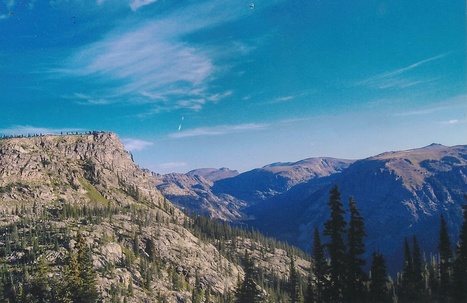 There are times in our lives when the best thing we can do for ourselves is to fill our backpacks with some food, a sleeping bag, maybe a tent, and take a nice long, solo walk in the woods. I feel this urge quite frequently, but rarely follow through with it anymore, always finding some sort of excuse or distraction to keep me from doing it - work, mowing the grass, dinner plans, stairs needing swept, dogs needing walks, my old knees. In the end, I usually take day trips which, under a microscope with the right lens, feel like a backpacking trip - at least that’s how I try to see it. It’s on these trips into the backcountry where we are able to clear out the build up of muck, much like sediment settling behind a dam, between our ears, in order to create some headspace and hopefully figure a few things out with the fly rod and some open water. Back in my early 20’s, when it came to catching trout on a fly, I had no idea what I was doing. However, I did know how to hike, how to camp, and how to be alone. So, with a three day weekend and a box of wooly buggers, I hitched up my pack and set off for a backcountry lake. I had been working in Rocky Mountain National Park on their trail crew for a couple of months and at that point I hiked what seemed like hundreds miles of the west side trails with a chainsaw on my shoulder, seeing a ton of the park and rolling my ankles and busting my knees in the process. I was barely a fly fisherman, using a wooly bugger exclusively, but I still walked to the Colorado River every Saturday morning to try and catch something. Eventually, I began to hear mythical stories about a lake full of cutties who would eat anything. This sounded like my kind of place since I still didn’t really know what a dragless drift was or how to match a hatch. Plus, the muck had been building up for quite some time, even though I lived and worked in the woods. I needed to get out of my shared living space and into the wilderness. I needed to pound the ground for something other the work - to explore and get lost. The lake sits in a little basin at 10,700 feet between two peaks on the west side of the park. The first 7 miles up the trail to the junction of the lake trail meanders through a dense valley along a quintessential mountain creek. Once you reach the junction and get onto the connector trail, you hit switchbacks and quickly gain elevation. At this point, your legs begin to burn and you lower your head, hitch your pack up so it doesn’t sit so low, and, in your mind’s eye, begin fishing. I reached the lake and the little breath I had left was taken from me. The clarity of the lake stared back at me, reflecting off my eyes and blinding all of my sub-conscious into finally believing that I was alone. I threw down my pack and jostled out my fly rod and tied on a black wooly bugger. I figured I’d set up camp later; the water was calling me. I found a rock to stand on protruding from the clear alpine water. My feet sank into my sandals as my weight molded them to the rock while I cast into the lake from mid day sun to sunset. Clouds reflected in the water and I swear I could see the pink and red of the cutties in the swirls of the lake. The clear lake, the burning sun of peaks outlining this alpine alcove, my black wooly bugger slinging through the air. Even 10 years later I can feel my feet in my sandals wrapped around that rock, holding my weight as I cast, strip, set the hook, play the fish in, release. Cast, strip, hook, play, release. Over and over again for what now seems like an eternity. Water dripped off my line as I reeled in after my last catch and I laughed out loud to myself; I was finally catching trout on a fly. All it took was ten miles, a few thousand feet in elevation, and a wild lake that still burns in my mind. The twilight came over the peaks as the sun set behind my mind. With rod in hand, I stood on a lone rock, watching the water settle under the moonlight. I finally felt like a fly fisherman. I flipped on my headlamp and headed back to make camp. I added some hot water to a pouch and had a quick dinner before I nestled into my sleeping bag between the peaks, lulling me to a deep sleep. Before heading home the next morning, I flicked my bugger out a few times and gently released a few more cutties. I don’t really remember walking the 10 miles back out to the car; my mind was still on that lake and those fish. Every fisherman needs a lake like this at some point; a place where they can chuck what they know, like a black wooly bugger, and catch trout after trout (or even just a few). It’s good for the confidence and on days in the future where they are struggling to catch anything, they can venture into the backcountry of their minds and relive that moment. We need that body of water that lets us catch fish and the backcountry that whispers sweet nothings of confidence to us. We need it to clear our head and lift our lines. Note: I wrote this about ten years ago while working on the Baxter State Park Trail Crew and recently stumbled across it. I figured I'd throw it up here as an artifact and because it was from a pretty influential part of my life. Eventually it might be part of a longer piece about trail work and the amazing experiences it provided me. The BSP Crew was my first of three trail crews I signed on to after college. Looking back, I think I learned more from those three years of working in the woods, traveling the country, and sleeping in a tent than I had in college. Those experiences helped shape who I am today and I am forever thankful for them.  For eight days in a row I wake up, slide on my steel toe boots, drink two cups of coffee, slam down a heart-attack sandwich (bagel, thick slab of cheddar, double eggs, and as much bacon as possible) and head out the door towards Katahdin Stream Campground. From there, my crew and I hike up the Hunt Trail, also known as the Appalachian Trail, to work on the Stairway to Heaven. This project, a series of rock staircases starting right above Katahdin Stream Falls, ascends Katahdin for another mile or so towards the glorious peak, the finish, the northern terminus of the Appalachian Trail. Since 1991, the trail crews at Baxter State Park, along with many trail volunteers of all ages, have worked thousands of hours and dedicated buckets of sweat and grit quarrying, hauling, rolling and setting large pieces of granite into the Appalachian Trail. The rock set in the trail becomes an impermeable tread way surface, slowing the erosion of the trail caused by water and usage, creating a beautiful path up the mountain. 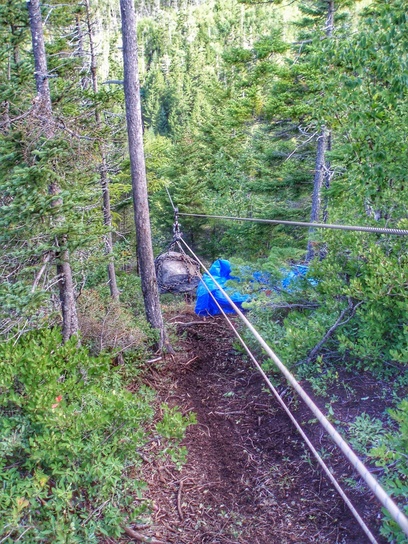 There are many steps involved in the process of building the Stairway to Heaven. Our crew splits the work up into different stations, which we rotate through during the week. Because of the size of the project, it works at its most efficient with at least 20 people involved. The Baxter State Park trail crew consists, on average, of 10-15 people, which means that volunteers are an integral part of this project. The rock is first quarried down in the pit (the “pit” station), which is located in the ravine between Katadhin and Owl Mountains. In the pit, the granite is split into workable, step-size pieces. The larger pieces are drilled with a rock drill, and then split using feathers and wedges. These pieces are then wrapped with chain, hooked onto a snatch-block, which runs on a 500-foot piece of wire rope from one Grip Hoist to another, and lifted 80 feet into the air. Once the load is lifted to its highest point, the crew retrieves the load (the “hand crew” station), pulling it towards the landing zone alongside the Appalachian Trail. The rigging system our crew uses consists of two grip hoists, one stationed on the side of Katahdin (the “Monster” station), and the other on the side of the Owl (the “Owl” station). These grip hoists, or winches, pull the wire rope tight to lift the load and slowly slacken the wire rope to lower the load. Once all the rock is brought to the work site, individual rocks are rolled down trail to pre-determined areas to be meticulously built into rock staircases. Some days are long, especially when you’re stuck pulling in the load with your shoulders and arms burning from exhaustion. Some days go quick, wrapping the rock in chain, hooking it up to the system and watching it fly high above and once it’s in the clear, drilling or scoring another large rock. Harvesting and wrapping. Drilling and hammering. Rolling and setting. There is a rhythm, much like hiking, that you can allow yourself to step into.
The entire process, from harvesting rock out of the pit, to moving trail side, to building a staircase out of the material, takes countless hours of hard labor. However, all those hours add up into a beautiful path that, hopefully, will be there for as long as the mountain. Our first true winter day came about this weekend. Blustery, cold, and raw. I decided to explore some new water in southern York County, Pennsylvania. Heading downstream, making my way through a landscape of naked trees and scrubby oaks, I met an injured doe and spooked a nice buck. Luckily, rifle season just ended so I didn't run into any hunters, though out of habit my eyes kept scanning the second horizon of the canopy in search of tree stands in use. With the temperatures dropping, the fish were sliding into their slow, spooky winter state of mind. This stretch of water runs through some farm fields and wooded pastures. The water was on the lower side, so fishing upstream and far back proved to be most productive. A stealth approach, something I'm in dire need of improving, was needed. The wild browns were keyed in on flashy stuff: greenie weenies, frenchies, & pink san juan worms drifted low and deep. They hung up at the bottom of pools and tucked in the undercut of the bank. It's always good to explore new water, to test your knowledge and skill, and to push yourself to get caught in brambles and accidentally step into some sweet holes in order to find new fish and new stories. I'll be heading back to this stretch in the spring, when the water is higher and the top-water action on point.
|
|

www.mgarrigan.com by Michael Garrigan is licensed under a Creative Commons Attribution-NonCommercial-NoDerivatives 4.0 International License.










